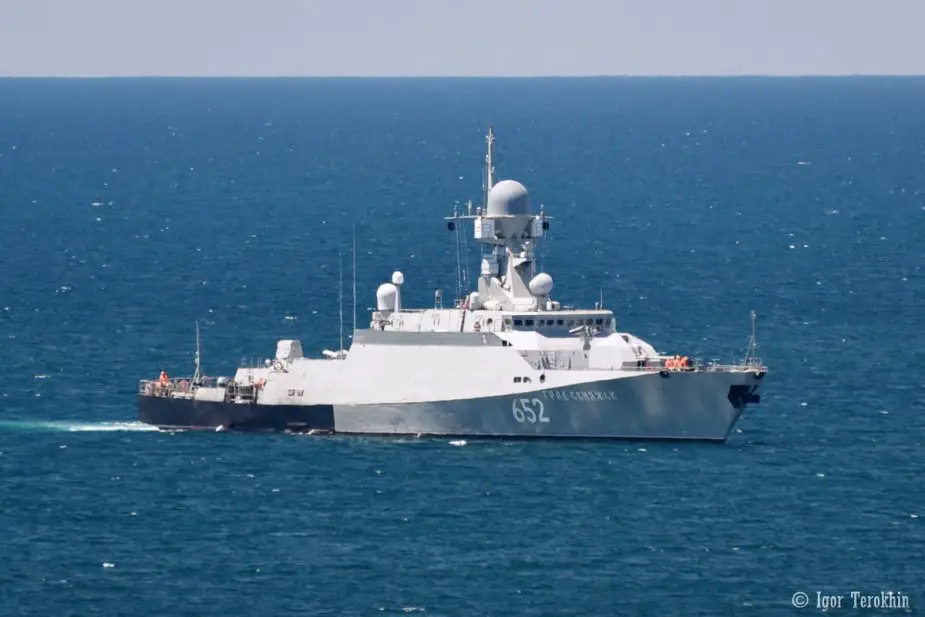Breaking news
Russian Grad corvette to operate in Baltic fleet.
The Russian Baltic fleet will operate the Grad Sviyazhsk corvette of Buyan-class project 21631. It is to be constructed in 2021 and will join the 36th brigade of missile ships in Baltiisk. It was initially planned to send the corvette to the Black Sea fleet, the Izvestia daily writes. The Baltic fleet will form the crew for the new warship by the end of 2020 and will send the navymen to a training center, Defense Ministry sources said. They will participate in trials of the Grad from 2021.
Follow Navy Recognition on Google News at this link
 Grad Sviyazhsk corvette of Buyan-class project 21631 (Picture source: Igor Therokin)
Grad Sviyazhsk corvette of Buyan-class project 21631 (Picture source: Igor Therokin)
Project 21631 corvettes are small ships with a displacement of 850 tons. They were initially designed to protect the maritime economic zone, but the mission was revised. In October 2015, three corvettes of project 21631 — the Uglich, the Grad Sviyazhsk, and the Veliky Ustyug — fired Kalibr missiles at terrorists in Syria from the Caspian Sea. In 2016, the Zeleny Dol and the Serpukhov corvettes of the project delivered a strike at extremists in Syria from the Eastern Mediterranean.
The strikes confirmed that despite a small size of project 21631 corvettes they have considerable firepower and can deliver precision missile strikes at a distance of 1,500 kilometers.
Project 21631 corvettes are currently operated by the Caspian flotilla, the Baltic and Black Sea fleets. The Caspian and Black Sea fleets have three corvettes each. The Baltic fleet operates the Zeleny Dol and the Serpukhov. The Grad laid in 2017 will be the third corvette there.
The Zeleny Dol and the Serpukhov have properly operated, expert Dmitry Boltenkov said. “Therefore, it was decided to send another corvette of the project to the Baltic Sea, as three warships comprise a tactical group. In case of an aggression against Russia, the Grad will fire additional Kalibr missiles and increase the capabilities of the Russian force in the region. Anyway, the combat composition of the 36th brigade has to be changed sooner or later, as the formation still operates Soviet-built missile ships,” he said.
Expert Vladimir Anokhin believes Kalibr carriers in the Baltic Sea is a warning to foreign politicians. “The small ships with a high firepower provide a broad range of possibilities to influence not very friendly neighbors, if necessary,” he said.
The size of corvettes provides good maneuvering capabilities. They can enter bays and fire from there. The long range of Russian cruise missiles will help the corvettes avoid risks, Anokhin said.
Project 21631 corvettes have eight-cell universal vertical launcher for Kalibr missiles and artillery arms. In 2020, the corvettes were upgraded for small robots and can lay mines now to block entry to straits and approaches to naval bases.
Project 21631 corvettes are included into the so-called reconnaissance-strike and reconnaissance-fire forces. They are thus universal attack platforms capable of interacting with ground forces. All the necessary reconnaissance information is transmitted to the warship by Strelets complex. It is suffice for a soldier on the coast to mark the target on his gadget and an artillery or missile strike will follow, the Izvestia said.
© Copyright 2020 TASS Navy Recognition. All rights reserved. This material may not be published, broadcast, rewritten or redistributed.


























